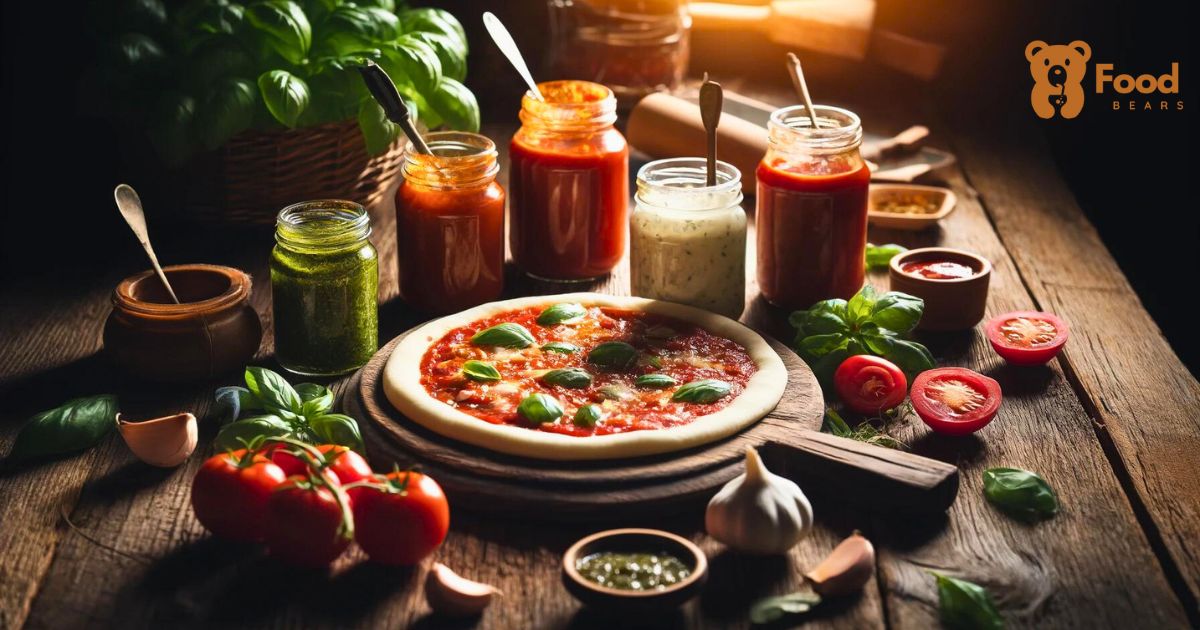When you think about pizza, what’s the first thing that springs to mind? For many, the vibrant and inviting layer of sauce truly defines a pizza’s character.
The sauce is not just a base; it’s the soul of the pizza, imbuing each bite with rich flavors and a sumptuous aroma. Beyond the well-loved traditional tomato sauce, a world of diverse sauces awaits your pizza experience.
Today, we’re diving into an exciting mix of pizza sauce recipes that satisfy any culinary explorer. From the classic Italian sauces that have charmed generations to modern twists and international infusions, this collection is your ticket to becoming a pizza maestro at home.
Whether you’re a fan of creamy, spicy, or tangy flavors, there’s something here for everyone. So, let’s broaden our horizons and add some new favorites to our pizza repertoire!
1. White Pizza Sauce
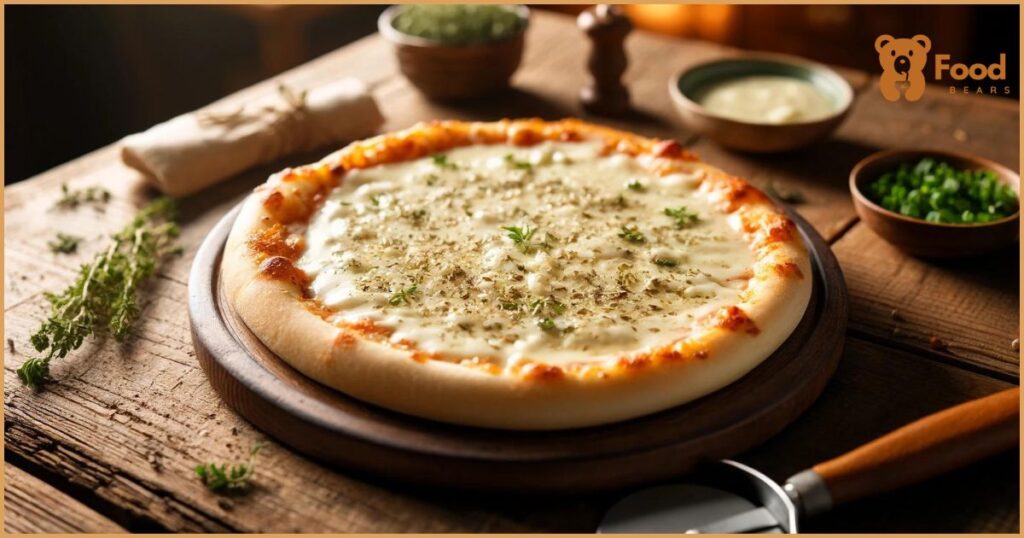
There’s something uniquely satisfying about a White Pizza Sauce. Unlike its tomato-based counterpart, this creamy sauce offers a velvety texture and a rich flavor that pairs wonderfully with various toppings.
It’s all about the silky, smooth embrace of cheeses and garlic, giving your pizza a luxurious twist.
Ingredients:
- 2 tablespoons butter
- 1 tablespoon minced garlic
- 2 tablespoons all-purpose flour
- 1 cup milk (preferably whole)
- 1/2 cup shredded mozzarella cheese
- 1/4 cup grated Parmesan cheese
- Salt and freshly ground black pepper to taste
Step-by-Step Preparation:
- Melt the Butter: In a medium saucepan over medium heat.
- Sauté Garlic: Add the minced garlic to the butter and sauté until fragrant, about 1 minute — don’t let it burn.
- Make a Roux: Sprinkle the flour over the butter and garlic. Stir continuously for about 2 minutes to cook off the floury taste.
- Add Milk: Gradually whisk in the milk, ensuring no lumps form. Keep whisking until the sauce begins to thicken.
- Add Cheeses: Lower the heat and stir in the mozzarella and Parmesan cheeses until smooth and fully incorporated.
- Season: Add salt and pepper to taste, adjusting according to your preferences.
Serving Suggestions:
Top your white sauce pizza with ingredients that complement its richness. Here are a few popular choices:
- Spinach and Artichoke: Pair with mozzarella for a classic spin.
- Chicken and Bacon: Add cooked, sliced chicken and crispy bacon for a meaty delight.
- Four Cheese: Combine mozzarella, ricotta, Gorgonzola, and extra Parmesan for a cheesy paradise.
- Broccoli and Cheddar: For a touch of green and a hint of sharpness.
Remember, the key to a perfect white pizza sauce is balance — not too thick or runny. It should just gracefully coat the back of a spoon. This sauce is a superb foundation for those who love their pizza rich and indulgent!
2. Classic Italian Pizza Sauce
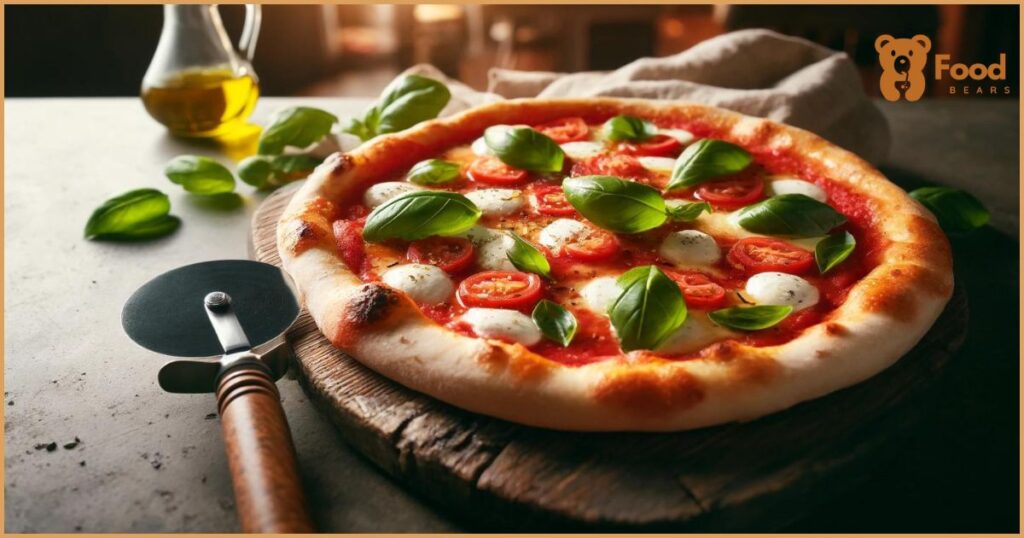
The heart of traditional Italian pizza is its sauce, steeped in history and simplicity.
Originating from the kitchens of Naples, the birthplace of pizza, this sauce reflects the essence of Italian cooking: fresh, straightforward ingredients brought together with care and passion.
Made primarily with tomatoes, the classic sauce is both vibrant and comforting.
Ingredients:
- 1 can (28 ounces) of San Marzano tomatoes, crushed
- 2 tablespoons extra-virgin olive oil
- 2-3 garlic cloves, minced
- 1 teaspoon sea salt
- 1/2 teaspoon sugar (optional, to balance acidity)
- 1/2 teaspoon dried oregano
- A few fresh basil leaves, torn
Step-by-Step Preparation:
- Heat the Olive Oil: In a saucepan, warm the olive oil over medium heat.
- Sauté Garlic: Add the minced garlic and sauté until it becomes fragrant, about 30 seconds. Be careful not to let it brown.
- Add Tomatoes: Stir in the crushed San Marzano tomatoes and their juices.
- Season: Sprinkle in the salt, sugar (if using), and oregano.
- Simmer: Let the sauce simmer gently for 20-30 minutes to thicken slightly and melt the flavors.
- Finish with Basil: Remove from heat and add the fresh basil leaves. Let them infuse for a few minutes before using.
Variations:
Personalizing your Italian pizza sauce can be a delightful culinary experiment. Here are some tips:
- Spice it Up: Add red pepper flakes for a bit of heat.
- Herb Infusion: Experiment with herbs like thyme or marjoram for a unique twist.
- Richer Flavor: For a deeper taste, include a splash of red wine during the simmering stage.
- Chunkier Texture: Use diced tomatoes instead of crushed ones for a more rustic feel.
This classic Italian pizza sauce is all about embracing the quality of your ingredients. Whether you keep it traditional or add your twist, the simplicity and freshness make it authentically Italian. Buon appetite!
3. Garlic Pizza Sauce
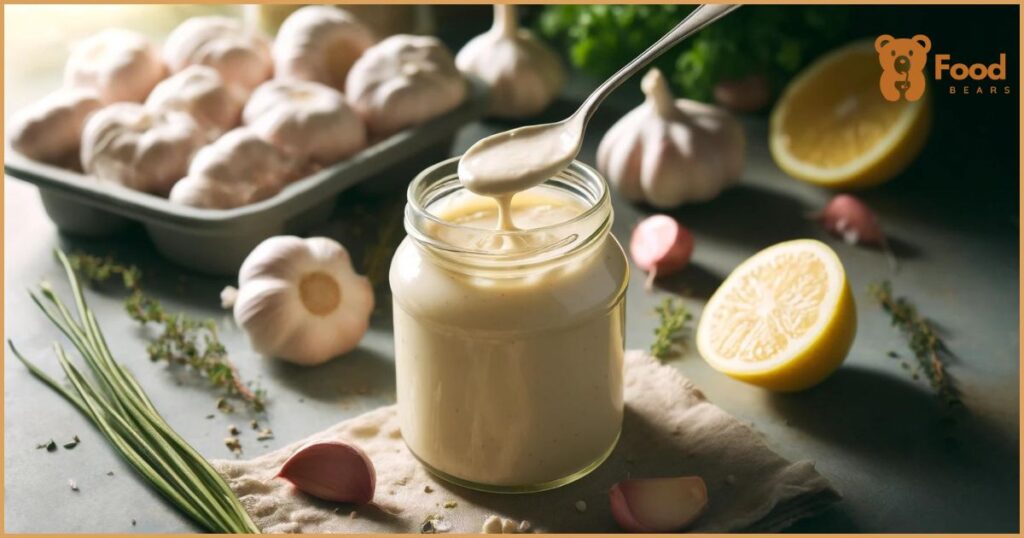
Garlic plays a starring role in many cuisines for a good reason. Its intense flavor and enticing aroma make it a perfect base for a bold, savory pizza sauce.
This sauce is a dream come true for garlic lovers, infusing every slice with a deep, rich garlic essence that enhances the other toppings.
Ingredients:
- 1/4 cup olive oil
- 8 cloves garlic, minced
- 2 tablespoons butter
- 3 tablespoons all-purpose flour
- 1 cup chicken or vegetable broth
- 1 cup milk
- 1/2 cup grated Parmesan cheese
- Salt and pepper to taste
Step-by-Step Preparation:
- Warm the Olive Oil: Heat the olive oil over medium heat in a saucepan.
- Cook the garlic: Add the minced garlic to the oil until it’s golden and fragrant, for about 2 minutes. This step is crucial as it builds the foundation of flavor.
- Add Butter and Flour: Stir in the butter until melted, then sprinkle the flour over the garlic. Cook, stirring continuously, to form a golden roux, about 1 minute.
- Whisk in broth and milk: Gradually add the broth and milk, whisking constantly to prevent lumps, and cook and stir until the sauce thickens, for about 5-7 minutes.
- Mix in Parmesan: Lower the heat and stir the grated cheese until the sauce is smooth and creamy—season with salt and pepper.
Pairing Ideas:
Choosing the right toppings can turn a garlic sauce pizza into an unforgettable meal. Here are some top pairing ideas:
- Roasted Vegetables: Such as bell peppers, zucchini, and eggplant. The sweetness of roasted veggies contrasts beautifully with the robust garlic flavor.
- Chicken or Sausage: Add cooked, sliced chicken breast or crumbled sausage for a heartier pizza.
- Spinach and Mushroom: These add earthiness and a touch of freshness that complements the garlic.
- Fresh Herbs and Ricotta: Dot with ricotta cheese and sprinkle fresh herbs like basil or oregano after baking for a fresh, aromatic finish.
This garlic pizza sauce promises a punch of flavor and transforms your pizza into a gourmet experience. It’s ideal for those who appreciate the bold and the beautiful in their culinary adventures!
4. Barbecue Pizza Sauce
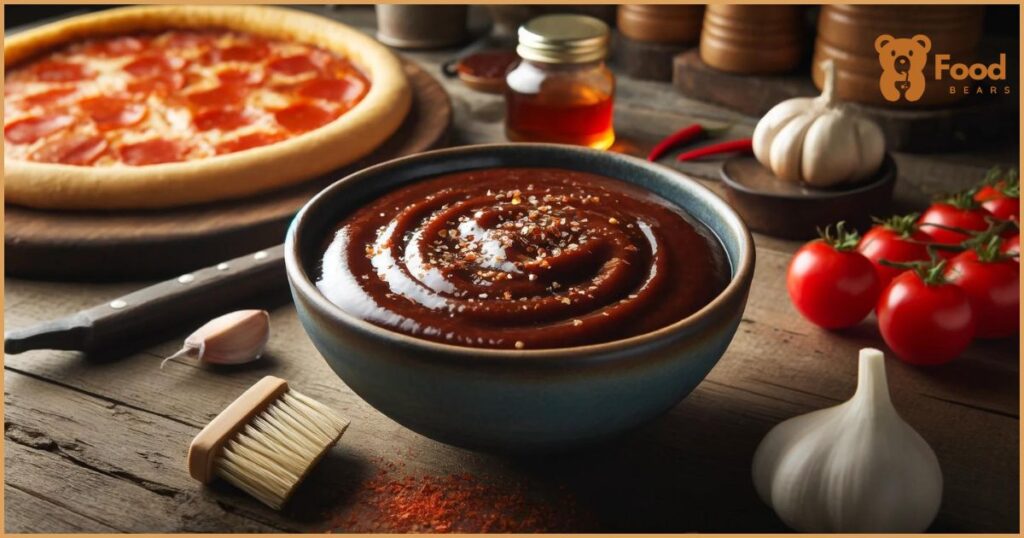
Barbecue pizza sauce is a delightful fusion where American barbecue tradition meets Italian pizza craftsmanship.
This sauce offers a smoky, tangy kick that elevates the pizza experience, blending well with various toppings to create something truly unique and mouthwatering.
Ingredients:
- 1 cup of your favorite barbecue sauce (choose a quality brand for best flavor)
- 2 tablespoons honey (optional for added sweetness)
- 1 tablespoon apple cider vinegar (for a bit of tang)
- 1 teaspoon smoked paprika (for extra smokiness)
Preparation:
- Mix Ingredients: In a bowl, combine the barbecue sauce, honey, apple cider vinegar, and smoked paprika. Stir until everything is well blended.
- Taste and Adjust: Sample your sauce. Adjust the sweetness or acidity depending on your preference. The goal is to reach a balanced flavor that complements your toppings.
- Apply to Dough: Spread the sauce evenly over your prepared pizza dough. A thin layer is sufficient, as barbecue sauce is typically more prosperous and flavorful than traditional pizza.
Suggested Toppings:
The right toppings can make your barbecue sauce pizza a hit. Here are some ideal choices:
- Grilled Chicken: Pre-cooked and chopped, it absorbs the sauce’s flavors wonderfully.
- Red Onions: Thinly sliced for a sharp contrast in flavor.
- Cilantro: Sprinkle fresh cilantro leaves over the cooked pizza for a burst of freshness.
- Smoked Gouda Cheese: Adds a depth of smoky flavor that pairs perfectly with the barbecue base.
- Bacon: Crispy bacon offers a nice crunch and salty bite.
For a truly delicious meal, experiment with combinations like chicken, red onion, cilantro, bacon, and smoked gouda. Barbecue pizza is perfect for those who love a bit of American zest in their Italian fare. It’s a bold choice for pizza night and a sure way to impress your guests!
5. Pesto Sauce
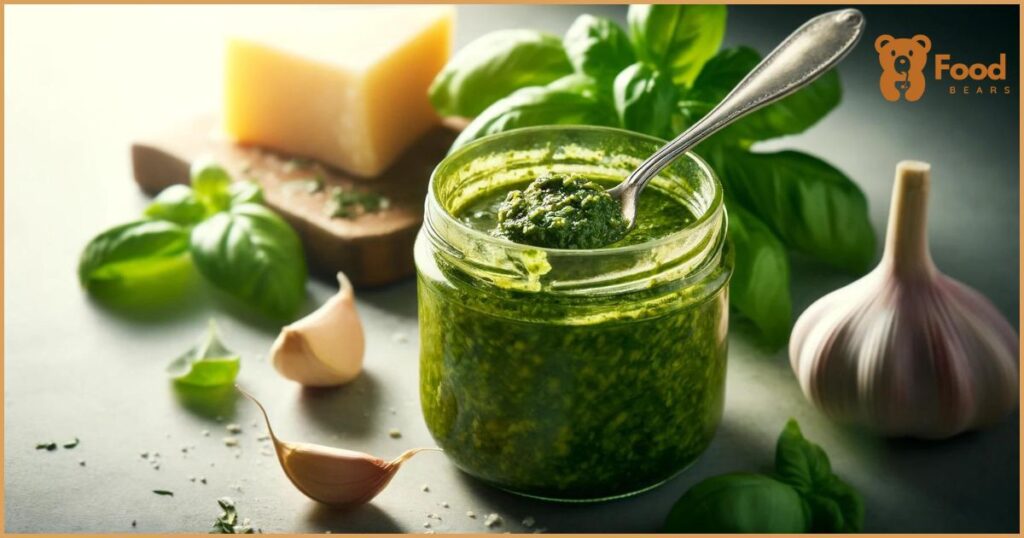
Pesto, originating from the Liguria region of Italy, is a vibrant and aromatic sauce that has gained immense popularity worldwide.
Traditionally made with basil, pine nuts, Parmesan, garlic, and olive oil, pesto brings a fresh and herbal flavor to dishes. Particularly pizza, which offers a delightful alternative to tomato-based sauces.
Ingredients:
- 2 cups fresh basil leaves, tightly packed
- 1/3 cup pine nuts (you can substitute with walnuts for a different twist)
- 2 large garlic cloves, peeled
- 1/2 cup extra-virgin olive oil
- 1/2 cup grated Parmesan cheese
- Salt and pepper to taste
Preparation:
- Combine Basil, Nuts, and Garlic: In a food processor, add the basil leaves, pine nuts, and garlic. Pulse until everything is coarsely chopped.
- Stream in Olive Oil: Slowly pour the olive oil while the processor runs. Process until the mixture becomes smooth and creamy.
- Add Cheese: Add the grated Parmesan cheese and pulse until well mixed—season with salt and pepper to taste.
- Adjust Consistency: If the pesto is too thick, add more olive oil to reach a spreadable consistency.
Usage Tips:
When using pesto on pizza, here are some tips to ensure the best results:
- Apply Sparingly: Because pesto is rich and concentrated in flavor, use it sparingly. A thin layer spread over the dough will suffice.
- Add at the Right Time: To preserve pesto’s vibrant color and flavor, consider adding it after baking the pizza, especially if using delicate ingredients that might not withstand high heat.
- Complementary Toppings: Pesto pairs wonderfully with toppings like sun-dried tomatoes, mozzarella, artichokes, and grilled chicken. These ingredients complement the herbal notes of the pesto without overpowering it.
Pesto sauce is a refreshing choice for those looking to add a green, nutty, and richly flavored dimension to their homemade pizzas. It’s a testament to the simplicity and elegance of Italian cooking, making any pizza night a special occasion.
6. Buffalo Chicken Sauce
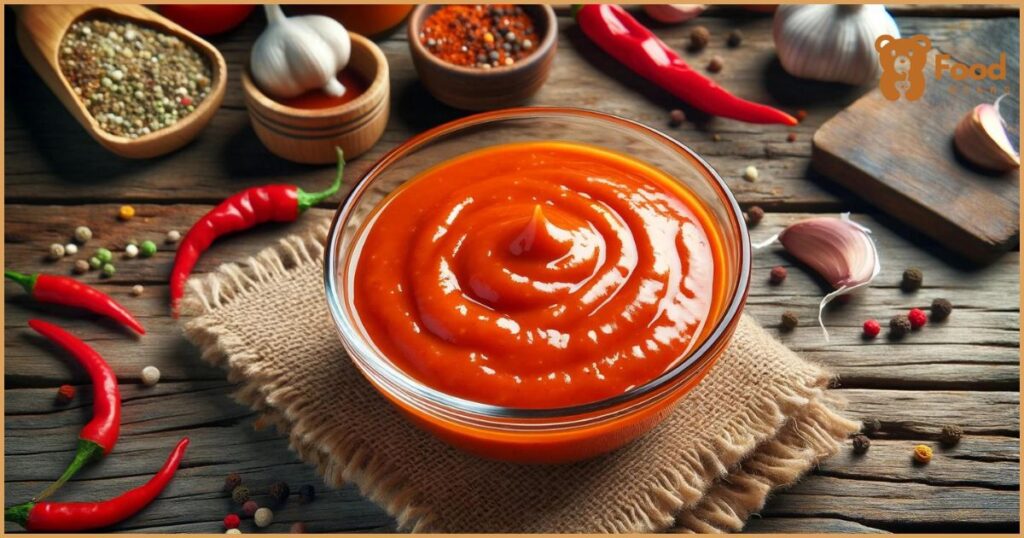
Merging the fiery zest of Buffalo wings with classic pizza, the Buffalo chicken sauce offers a bold, spicy kick. That transforms ordinary pizza into an extraordinary experience. This sauce is perfect for those craving heat and many flavors.
Ingredients:
- 1 cup hot sauce (like Frank’s Red Hot for authenticity)
- 1/2 cup unsalted butter
- 2 tablespoons white vinegar
- 1/2 teaspoon Worcestershire sauce
- 1/2 teaspoon cayenne pepper (adjust based on heat preference)
- 1/4 teaspoon garlic powder
Preparation:
- Combine Ingredients: In a saucepan, combine the hot sauce, butter, vinegar, Worcestershire sauce, cayenne pepper, and garlic powder.
- Heat to Merge Flavors: Cook over medium heat, stirring frequently until the butter is melted and the sauce is well combined.
- Simmer: Reduce the heat to low and let the sauce simmer for 5-10 minutes, stirring occasionally. The flavors will intensify as they meld.
- Cool Before Applying: Let the sauce cool slightly before applying it to the pizza dough. This prevents the dough from becoming soggy.
Suggested Pizza Toppings:
The spicy and tangy nature of Buffalo chicken sauce pairs well with a variety of toppings that can handle its boldness:
- Grilled Chicken: Pre-cook and dice or shred chicken to soak up more sauce.
- Blue Cheese: Offers a creamy, tangy counterbalance to the heat.
- Celery: Adds a refreshing crunch and cools the palate.
- Mozzarella Cheese: A milder cheese that lets the sauce shine.
- Red Onions: Their sharpness complements the spice.
This pizza is a crowd-pleaser at gatherings, especially for those who love a spicy kick. Buffalo chicken pizza combines the best of two worlds, making it a flavorful and exciting choice for any pizza night.
7. Alfredo Sauce
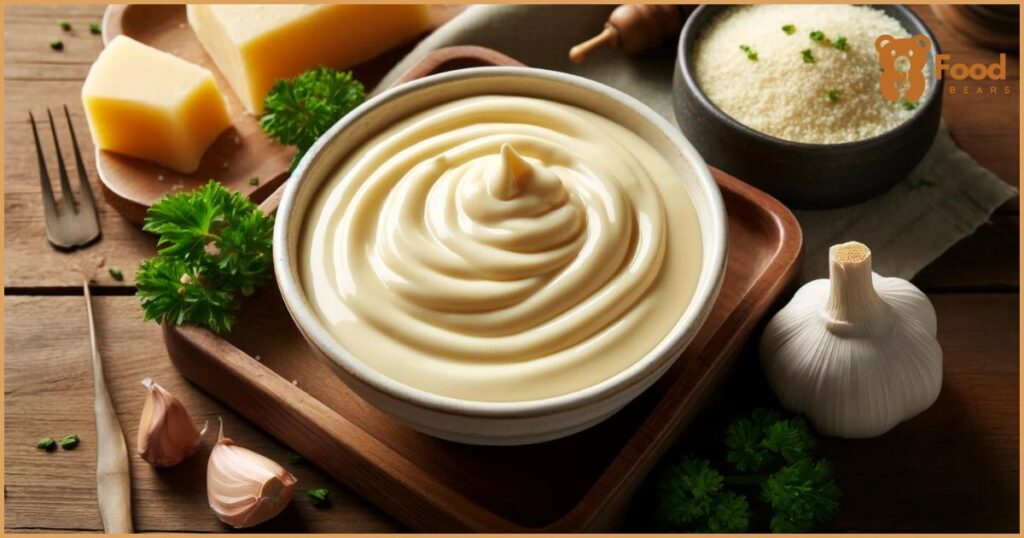
Alfredo sauce brings a decadent and creamy richness to pizza, offering a luxurious alternative to more traditional sauces.
Originally from Rome, this sauce’s velvety texture and buttery flavor make it a beloved choice for those seeking a more gourmet pizza experience.
Ingredients:
- 1/4 cup unsalted butter
- 1 cup heavy cream
- 2 cloves garlic, minced
- 1 1/2 cups freshly grated Parmesan cheese
- Salt and pepper to taste
- A pinch of nutmeg (optional for added depth)
Preparation:
- Melt Butter: In a saucepan over medium heat, melt the butter.
- Add Garlic: Sauté the minced garlic in the butter until it’s fragrant, about 1-2 minutes.
- Pour in Cream: Slowly add the heavy cream to the saucepan, stirring constantly.
- Simmer: Allow the mixture to simmer gently for a few minutes to thicken slightly without boiling.
- Add Cheese: Gradually stir in the grated Parmesan cheese until it melts into the sauce and becomes smooth and creamy.
- Season: Season with salt, pepper, and a pinch of nutmeg if using. Stir well to combine.
Recommended Toppings:
Alfredo sauce’s creamy base is wonderfully versatile and pairs well with a variety of toppings that complement its rich profile:
- Grilled Chicken: Sliced grilled chicken breast adds a hearty protein component.
- Spinach: Fresh or sautéed spinach provides a touch of color and earthiness.
- Mushrooms: Sautéed mushrooms offer a meaty texture and soak up the sauce’s flavors.
- Bacon: Crispy bacon pieces lend a smoky, salty crunch that contrasts nicely with the creamy sauce.
- Artichokes: Marinated artichoke hearts introduce a tangy element that cuts through the richness.
Alfredo sauce on pizza is a truly indulgent treat that elevates your meal to a luxurious dining experience. Perfect for a cozy night in or a special occasion, it’s sure to impress with its creamy texture and rich, comforting flavor.
8. Spicy Tomato Sauce
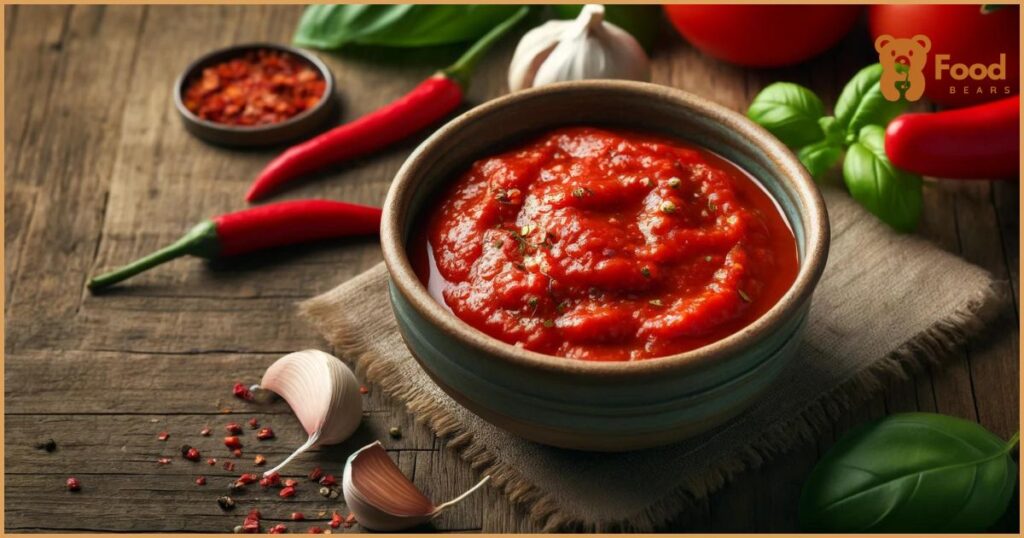
A spicy tomato sauce is the perfect answer for those who crave more excitement on their pizza.
This sauce takes the beloved classic tomato base and elevates it with a kick of heat, adding a refreshing layer of flavor that ignites the palate.
Ingredients:
- 1 can (28 ounces) crushed tomatoes
- 2 tablespoons olive oil
- 3 cloves garlic, minced
- 1-2 teaspoons red pepper flakes (adjust based on your heat preference)
- 1 teaspoon smoked paprika
- 1/2 teaspoon onion powder
- Salt to taste
- Fresh basil or oregano for garnish
Preparation:
- Heat Olive Oil: Heat the olive oil over medium heat in a saucepan.
- Sauté Garlic and Spices: Add the minced garlic, red pepper flakes, and smoked paprika. Cook until garlic is fragrant, and spices are toasted for 1-2 minutes.
- Add Tomatoes: Stir in the crushed tomatoes and onion powder. Mix well to incorporate all the flavors.
- Simmer: Reduce the heat and let the sauce simmer for 20-30 minutes to allow the flavors to meld and the sauce to thicken.
- Season: Add salt to taste and adjust the seasoning as needed. Finish with chopped fresh herbs for added freshness.
Topping Suggestions:
Choosing the right toppings can help balance the spiciness of the sauce and enhance the overall flavor profile:
- Mozzarella Cheese: The creaminess helps mellow out the heat.
- Grilled Chicken or Shrimp: Adds a protein-packed dimension that pairs well with the bold sauce.
- Pineapple: Offers a sweet contrast to the spicy sauce.
- Green Peppers and Red Onions: Provide a crunchy, fresh texture and sharpness.
- Fresh Cilantro: Sprinkle over the cooked pizza for a burst of herbal freshness.
This spicy tomato sauce is perfect for those who like pizza with a bit of a punch. It’s a vibrant and flavorful choice that will wake up all your taste buds!
9. Vegan Bechamel Sauce
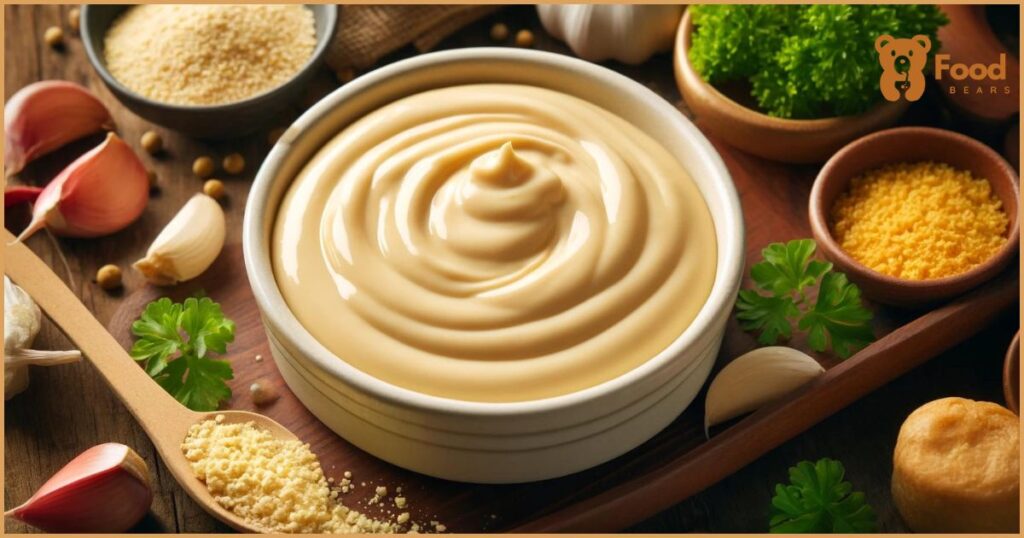
A vegan béchamel sauce offers a creamy, luxurious alternative to traditional pizza sauces. Making it a fantastic option for those following a vegan diet or experimenting with dairy-free options.
This sauce combines the classic elements of béchamel with plant-based substitutes to create a rich and smooth topping for pizza.
Ingredients:
- 2 tablespoons vegan butter
- 2 tablespoons all-purpose flour
- 1 1/2 cups unsweetened almond milk (or any other plant-based milk)
- 1/4 teaspoon ground nutmeg
- Salt and white pepper to taste
- 2 tablespoons nutritional yeast (for a cheesy flavor)
Preparation:
- Melt Vegan Butter: In a saucepan, heat the vegan butter over medium heat until melted.
- Make a Roux: Add the flour to the melted butter, stirring continuously to form a smooth paste. Cook for about 2 minutes to remove the raw flour taste.
- Gradually Add Milk: Slowly whisk the almond milk, ensuring no lumps. Continue to whisk until the sauce starts to thicken.
- Season the Sauce: Add nutmeg, salt, and white pepper. Adjust the seasoning to your taste.
- Add Nutritional Yeast: Stir in nutritional yeast for a subtle cheesy flavor and additional nutrients. Cook for another minute until the sauce reaches your desired consistency.
Pizza Topping Recommendations:
The neutral but creamy flavor of vegan béchamel sauce makes it a versatile base that can be paired with a variety of toppings:
- Roasted Vegetables: Such as red peppers, zucchini, and mushrooms.
- Spinach and Kale: Add a green, leafy component that cooks down nicely.
- Artichoke Hearts and Olives: Offer a Mediterranean flair with their distinct flavors.
- Sliced Tomatoes and Basil: For a fresh and simple topping.
- Vegan Cheese: If you’re missing that stretchy cheese pull, sprinkle some shredded vegan cheese before baking.
Vegan béchamel sauce is a testament to the versatility of plant-based cooking, proving that you don’t have to sacrifice flavor for dietary preferences.
Whether you are a full-time vegan or just dabbling in dairy-free options, this sauce will impress with its creamy texture and adaptable flavor.
10. Pizza Without Tomato Sauce or Cheese
Daring to deviate from the classic path, some pizzas break all the rules delightfully. A pizza without tomato sauce or cheese may sound unconventional, but it opens up a world of creativity and flavor.
This approach caters to dietary restrictions or simply a desire for something different, turning limitations into an art of flavor exploration.
Ingredients:
- Olive oil or garlic-infused oil for brushing the base
- Fresh vegetables like sliced bell peppers, onions, and spinach
- Proteins such as sliced chicken breast, prosciutto, or smoked salmon
- Herbs and seasonings like rosemary, thyme, or za’atar
- Optional garnishes such as pine nuts, capers, or olives
Preparation and Toppings:
- Prepare the Base: Brush your pizza dough with olive or garlic-infused oil. This adds moisture and flavor, compensating for the lack of sauce.
- Choose Flavorful Vegetables: Layer your chosen veggies on the dough. Consider pre-roasting or sautéing vegetables like onions or bell peppers to enhance their sweetness and depth of flavor.
- Add Protein: If desired, add slices of chicken, prosciutto, or smoked salmon for a richer experience. These proteins bring robust flavors that stand well without cheese.
- Season Well: Herbs and spices play a critical role here. Fresh or dried herbs like rosemary, thyme, or even a sprinkle of za’atar can dramatically lift the flavors.
- Bake: Cook your pizza in a preheated oven at a high temperature until the edges are golden and crispy, and the toppings are cooked through.
- Finish with Garnishes: After baking, enhance your pizza with fresh garnishes like arugula, a drizzle of truffle oil, pine nuts, capers, or a squeeze of lemon for added zing.
Suggested Toppings:
- Mediterranean Style: Sliced olives, artichoke hearts, red onion, a sprinkle of fresh dill, and a drizzle of extra virgin olive oil.
- Garden Delight: Spinach, kale, mushrooms, and a dash of nutmeg or black pepper, finished with a splash of balsamic reduction.
- They were smoked Salmon Pizza: A base of garlic-infused oil, topped with salmon, capers, thinly sliced red onions, and a garnish of fresh dill.
Exploring pizza without traditional sauce or cheese is an exciting journey into taste and texture. It challenges the norm, invites innovation, and often creates a delightful culinary.
Conclusion
We’ve explored an incredible array of pizza sauce options, each with its unique flavor profile and culinary charm.
From the rich, creamy layers of Alfredo and vegan béchamel to the zest and pep of spicy tomato and Buffalo chicken, these sauces are designed to transform your homemade pizza into a delectable masterpiece.
Pizza isn’t just about sticking to old favorites; it’s about discovery and adventure in your kitchen. I encourage you to experiment with these recipes and mix and match them with different toppings. And find what delights your palate the most.
Maybe the bold kick of a spicy sauce or the subtle elegance of a white garlic base captures your culinary heart.
Remember, the best pizza comes from creativity and personal taste. So, don your chef’s hat, fire up your oven, and start crafting pizzas that are indeed your own. Who knows? Your new favorite might be a recipe away!

Ella Foster, co-founder of FoodBears.com, is a skilled writer whose love for cooking fuels her creative work. Her passion for experimenting in the kitchen brings authentic flavor and culinary inspiration to every piece she crafts for the platform.
